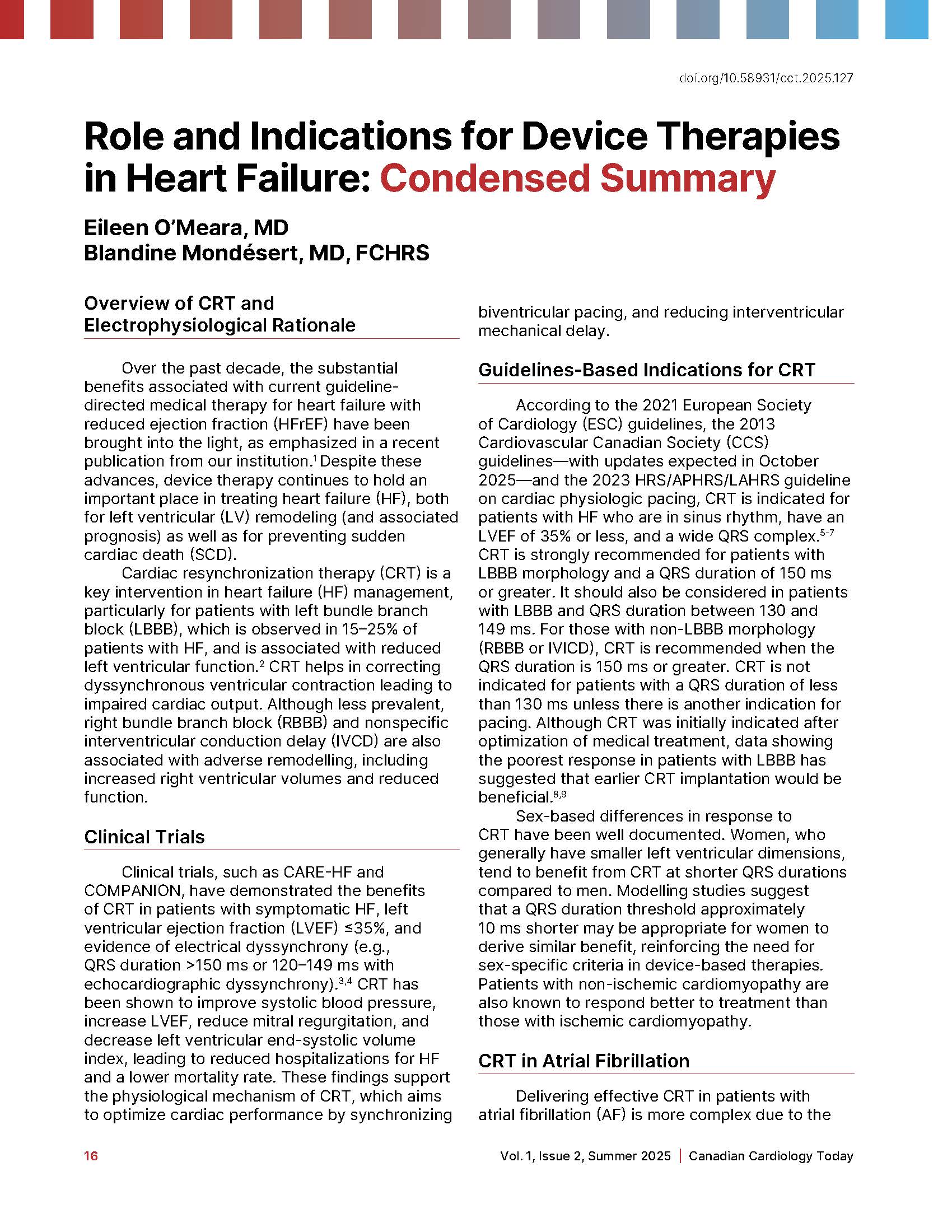Role and Indications for Device Therapies in Heart Failure: Condensed Summary
DOI:
https://doi.org/10.58931/cct.2025.127Abstract
Over the past decade, the substantial benefits associated with current guideline-directed medical therapy for heart failure with reduced ejection fraction (HFrEF) have been brought into the light, as emphasized in a recent publication from our institution. Despite these advances, device therapy continues to hold an important place in treating heart failure (HF), both for left ventricular (LV) remodeling (and associated prognosis) as well as for preventing sudden cardiac death (SCD).
Cardiac resynchronization therapy (CRT) is a key intervention in heart failure (HF) management, particularly for patients with left bundle branch block (LBBB), which is observed in 15–25% of patients with HF, and is associated with reduced left ventricular function. CRT helps in correcting dyssynchronous ventricular contraction leading to impaired cardiac output. Although less prevalent, right bundle branch block (RBBB) and nonspecific interventricular conduction delay (IVCD) are also associated with adverse remodelling, including increased right ventricular volumes and reduced function.
References
Jarjour M, Leclerc J, Bouabdallaoui N, Ahnadi C, Brouillette D, de Denus S, et al. Optimization of pharmacotherapies for ambulatory patients with heart failure and reduced ejection fraction is associated with improved outcomes. Int J Cardiol. 2023;370:300-308. doi:10.1016/j.ijcard.2022.09.058 DOI: https://doi.org/10.1016/j.ijcard.2022.09.058
Abe TA, Evbayekha EO, Jackson LR 2nd, Al-Khatib SM, Lewsey SC, Breathett K. Evolving indications, challenges and advances in cardiac resynchronization therapy for heart failure. J Card Fail. Published online April 16, 2025. doi:10.1016/j.cardfail.2025.01.031 DOI: https://doi.org/10.1016/j.cardfail.2025.01.031
Cleland JG, Daubert JC, Erdmann E, Erdmann E, Freemantle N, Gras D, et al. The effect of cardiac resynchronization on morbidity and mortality in heart failure. N Engl J Med. 2005;352(15):1539-1549. doi:10.1056/NEJMoa050496 DOI: https://doi.org/10.1056/NEJMoa050496
Bristow MR, Saxon LA, Boehmer J, Kreuger S, Kass DA, De Marco T, et al. Cardiac-resynchronization therapy with or without an implantable defibrillator in advanced chronic heart failure. N Engl J Med. 2004;350(21):2140-2150. doi:10.1056/NEJMoa032423 DOI: https://doi.org/10.1056/NEJMoa032423
Exner DV, Birnie DH, Moe G, Thibault B, Philippon F, Healey JS, et al. Canadian Cardiovascular Society guidelines on the use of cardiac resynchronization therapy: evidence and patient selection. Can J Cardiol. 2013;29(2):182-195. doi:10.1016/j.cjca.2012.10.006 DOI: https://doi.org/10.1016/j.cjca.2012.10.006
Chung MK, Patton KK, Lau CP, Dal Forno ARJ, Al-Khatib SM, Arora V, et al. 2023 HRS/APHRS/LAHRS guideline on cardiac physiologic pacing for the avoidance and mitigation of heart failure. Heart Rhythm. 2023;20(9):e17-e91. doi:10.1016/j.hrthm.2023.03.1538 DOI: https://doi.org/10.1016/j.hrthm.2023.03.1538
Glikson M, Nielsen JC, Kronborg MB, Michowitz Y, Auricchio A, Barbash IM, et al. 2021 ESC Guidelines on cardiac pacing and cardiac resynchronization therapy. Eur Heart J. 2021;42(35):3427-3520. doi: 10.1093/eurheartj/ehab364. DOI: https://doi.org/10.1093/eurheartj/ehab699
Leyva F, Zegard A, Patel P, Stegemann B, Marshall H, Ludman P, et al. Improved prognosis after cardiac resynchronization therapy over a decade. Europace. 2023;25(6):euad141. doi:10.1093/europace/euad141 DOI: https://doi.org/10.1093/europace/euad141
Chi WK, Gong M, Bazoukis G, Yan BP, Letsas KP, Liu T, et al. Impact of coronary artery chronic total occlusion on arrhythmic and mortality outcomes: a systematic review and meta-analysis. JACC Clin Electrophysiol. 2018;4(9):1214-1223. doi:10.1016/j.jacep.2018.06.011 DOI: https://doi.org/10.1016/j.jacep.2018.06.011
Mullens W, Dauw J, Gustafsson F, Mebazaa A, Steffel J, Witte KK, et al. Integration of implantable device therapy in patients with heart failure. A clinical consensus statement from the Heart Failure Association (HFA) and European Heart Rhythm Association (EHRA) of the European Society of Cardiology (ESC). Eur J Heart Fail. 2024;26(2):483-501. doi:10.1002/ejhf.3150 DOI: https://doi.org/10.1002/ejhf.3150
Knops RE, Lloyd MS, Roberts PR, Wright DJ, Boersma LVA, Doshi R, et al. A modular communicative leadless pacing-defibrillator system. N Engl J Med. 2024;391(15):1402-1412. doi: 10.1056/NEJMoa2401807 DOI: https://doi.org/10.1056/NEJMoa2401807
Friedman P, Murgatroyd F, Boersma LVA, Manlucu J, Knight BP, Clementy N, et al. Performance and safety of the extravascular implantable cardioverter defibrillator through long-term follow-up: final results from the Pivotal study. Circulation. 2025;151:322–332. doi:10.1161/CIRCULATIONAHA.124.071795 DOI: https://doi.org/10.1161/CIRCULATIONAHA.124.071795
Okada DR, Smith J, Derakhshan A, Gowani Z, Misra S, Berger RD, et al. Ventricular arrhythmias in cardiac sarcoidosis. Circulation. 2018;138(12):1253-1264. doi:10.1161/CIRCULATIONAHA.118.034687 DOI: https://doi.org/10.1161/CIRCULATIONAHA.118.034687
Boulet J, Massie E, Mondésert B, Lamarche Y, Carrier M, Ducharme A. Current review of implantable cardioverter defibrillator use in patients with left ventricular assist device. Curr Heart Fail Rep. 2019;16(6):229-239. doi: 10.1007/s11897-019-00449-8 DOI: https://doi.org/10.1007/s11897-019-00449-8

Downloads
Published
How to Cite
Issue
Section
License
Copyright (c) 2025 Canadian Cardiology Today

This work is licensed under a Creative Commons Attribution-NonCommercial-NoDerivatives 4.0 International License.

